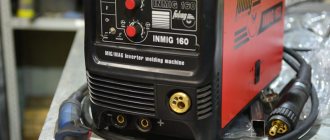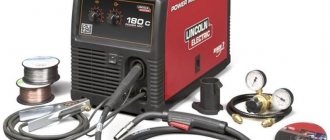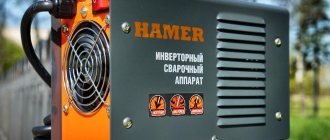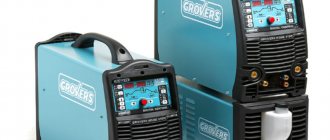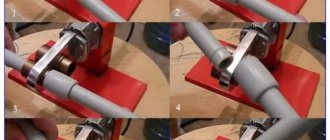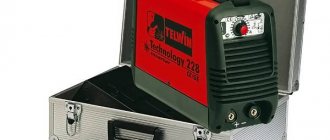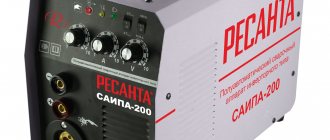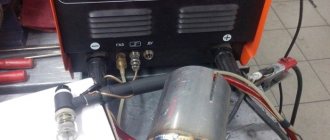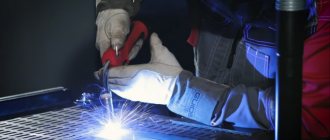A good semi-automatic welding machine is a necessary tool for work in the garage. Whether you're doing body work, patching up a muffler, or fixing a frame, welding is a must. That is why many car enthusiasts ask the question: “which semi-automatic welding machine is better to buy for the garage?” You will find the answer to this and many other questions about semi-automatic welding in this article.
Trans or inverter
Let's consider the pros and cons of transformer and inverter welding equipment. The advantages and disadvantages of each of them will help you make your choice.
The transformer semiautomatic device has simple adjustments on the front panel:
- wire feed speed;
- power - 1, 2, 3, etc. These are the stages of switching according to which the welder is guided by the thickness of the metal. For example, for welding 3 mm metal, set the machine to 4 or 5 (each has its own settings);
- Many transformers have a starting-charger (a convenient feature for cars).
The trans consists of a transformer, diodes for voltage rectification, resistors and thyristors, and a wire feed mechanism.
Disadvantages of transformer semi-automatic machines:
- large dimensions and weight;
- sensitive to voltage sags in the network. For example, when the voltage drops, the welder adds power to the machine and continues working. When the voltage increases, we get a burn through the metal;
- they eat up the tension by draining the network, everyone's lights flicker along the street (neighbors express dissatisfaction).
For areas where low voltage is a common occurrence, it is better to buy an inverter. But in case you don't cook in winter.
- It’s hard to burn a transformer, you need to try really hard.
- not afraid of dust, moisture, temperature. Can be cooked all year round.
Inverter semi-automatic welding machine for body work
- no starting charger;
- electrical boards collect dust, which reduces the durability of the device;
- there are many parts, any of them can fail;
- the inverter refuses to work at sub-zero temperatures.
- smooth power adjustment with digital display;
- high-quality seam, the device smoothes out voltage surges;
- light weight;
- cooks at reduced voltage and a long extension cord;
- uses energy economically;
- higher efficiency compared to a transformer.
Conclusion: it is afraid of dampness, dust and cold, but with careful care the inverter will last a long time.
Video:
Useful tips
So, you have made your choice. What else to pay attention to when buying a semi-automatic machine for the garage:
- The burner is the most wearable part; it must be removable and have a Euro connector. The built-in burner is designed for a maximum current of 130 A.
- Possibility of polarity replacement. On ground plus, on the torch minus for welding using flux-cored wire, without a carbon dioxide cylinder. Cored wire with filler inside, requires reverse polarity.
The negative clamp terminal comes with a spring from the factory, it is better to replace it. Buy a terminal where the two parts are connected by a special bus. This will reduce the current drop and the loss of spring elasticity.
So, which semi-automatic welding machine should you choose for car repair? Owners of transformers claim that there is nothing better than their equipment, but owners of inverters say the opposite. The choice is yours!
The best option is to purchase a trans and inverter. Use the inverter in the warm season, and the transformer in the winter.
Video:
How to weld body metal
Each car mechanic selects the equipment settings for himself. For example, for 1 mm of Soviet metal and 0.7 mm of foreign-made metal, the power on the transformer apparatus is set to 1 or 2. Wire feed to the average value. The pressure from the cylinder to the semiautomatic device is 0.1 MPa.
Before work, the metal of the car is cleaned of paint, primer and rust. Normal wire feed is set:
- With low feed, the seam turns out bad.
- At maximum feed, the seam looks like a bump, and there is an overuse of wire.
- The optimal value of wire exit from the torch to the welding surface is 1 cm.
Video:
Consumer Reviews
I use it in the auto repair shop to the fullest, I’m very happy with the purchase. The inverter is equipped with a EURO connector for connecting a 3-meter BINZEL gun. For ease of work, the device has a wire pulling button. Also, there are voltage and welding current adjustments.
The bobbin holder with brake adjustment allows you to install a coil weighing 5 kg. The wire feed mechanism is assembled from iron products. The housing has contacts that change polarity for welding with flux-cored wire.
The device is equipped with a quick-release ground clamp contact with a cross-section of 25 sq. mm. Let me note that when you cook for a long time at maximum values, the quick release overheats and slow burnout occurs. This is such a small flaw, otherwise everything is in order.”
Nikolay Rytov, 33 years old, Chita.
Cons: built-in 1.5 meter burner, weak for large jobs. The burner gets very hot. A short sleeve causes a lot of inconvenience when welding. I wanted to re-equip the device, install a Euro connector and buy a pistol from another manufacturer. But it turned out that the mechanical gas supply valve is located in the burner, and not on the equipment.
The quick-release contact of the mass has a cross-section of 25 sq. mm, which negatively affects the service life. The semi-automatic machine is not equipped with polarity reversal; you can’t cook it with cored wire. Changing the wire is inconvenient, the internal space is small. The feeding device was already breaking (plastic), so I had to buy another one.”
Nikita, 29 years old, Saratov.
Plus of the device: it cooks with wire and an electrode. True, during electric welding, the unit heats up (there is no cooler). There are no overheating problems when working with wire.
Welding machines for cars with additional options
Many models of welders that are used for car repairs have additional options :
- Maintenance (charging, removing sulfation from plates, etc.) of vehicle starter batteries. This allows you to use the welder during breaks between welding sessions for additional vehicle maintenance work and helps increase the profitability of the workshop;
- Starting a car engine in cold weather with a discharged battery. The option expands the capabilities of the welder. This is especially valuable in areas with harsh climates.
Welding machine + Starter-charger (3in1) AIRLINE AJS-W-03. Photo 220Volt
The inverter welder “AIRLINE AJS-W-03” is very popular. It performs electrode electric welding. In addition, it is a starting charger that charges 12 V and 24 V batteries and starts a car engine in unfavorable climatic conditions.
Advantages of a semi-automatic body work machine
When repairing a car, it is most often necessary to restore the body using welding work. Since it is made of metal of small thickness, semi-automatic welding should be performed with wire with a Ø of no more than 1 mm (usually 0.8 mm). Body repairs sometimes have to be combined with the repair of parts no more than 5 mm thick.
Therefore, inverter semi-automatic body machines are used with low or medium power. This is an ideal option for doing work in the garage. In workshops and service stations, a semi-automatic machine of a semi-professional or professional type is required.
The advantages of using semi-automatic auto body work are as follows:
- provide an even, narrow and durable seam;
- can be welded in any position;
- facilitate the work of the welder;
- increase labor productivity.
Functions and operations performed by a welder for a car
Repair using a welder includes not only welding (assembly and dismantling) work, but also other operations, for example, straightening .
Firstly, during this operation, deformed parts of the car body are pulled out using special equipment. To secure it to the surface, washers are welded to the key points of the dent. The hoist hook or the tip of the reverse hammer will subsequently be hooked onto them.
Welding machine AIRLINE AJS-W-03 with ROM and cables. Photo 220Volt
Secondly, the welder is often used to heat thick parts (for example, body parts in trucks, side members in cars) for further deformation.
In addition, repair welders often have additional options. Very common, for example, are designs that provide for equipping the welder with a charging and starting device. This device is intended for:
- maintenance of vehicle starter batteries;
- starting the car engine with a discharged battery.
Small-sized battery-powered welding inverters allow you to carry out urgent vehicle repairs right on the spot (on a remote highway). The electrical capacity reserve of one set of power supply is enough for simple welding repairs , and the heavy-duty vehicle will be able to continue moving without changing the route. If necessary, the repair team can take spare batteries with them.
Important criteria for selecting equipment
The main difference between a semi-automatic welding machine for body work and a conventional arc welding machine is the presence of a welding wire feeding mechanism. It is supplied to the welding zone automatically. You can choose a semi-automatic machine for the body joining or welding process of household, semi- and professional classes. It all depends on how it will be used over time, what current strength is needed to weld the metal and what its chemical composition is. Budget machines for body welding are designed to operate with a current of no more than 200 A with a power of up to 5 kW, semi-professional - up to 300 A with a power of up to 8 kW, professional - more than 300 A with a power of up to 25 kW. They also differ in cost. Professional machines are the most expensive, but they can handle not only body welding, but also solve other problems.
When choosing a semi-automatic machine for body welding, you need to pay attention to the following factors:
- voltage and frequency of the supply network, in V and Hz (220/50; 380/50);
- type (inverter, transformer, rectifier);
- power indicators in kW;
- range of supply voltage changes in%;
- the value of the open circuit voltage in V;
- range of current supplied to the electrodes in A;
- duration of switching on in%;
- type of wire (copper-plated, alloyed, flux-cored);
- type of wire feed (push, pull, combined);
- wire feed speed in m/min;
- coil type;
- hose length in m (1.5÷5);
- location of the coil (built into the body of the device or separately located);
- the presence of a coil recharging mechanism (with or without it);
- diameter of the welding wire used in mm (0.6÷1.6);
- Availability of voltage and current regulation.
The place where welding work is carried out should be equipped as shown in the following figure:
We pay special attention to the power source (must correspond to the supply network), the power indicators of the device, as well as the gas cylinder and burner. It is better to use carbon dioxide cylinders with a standard capacity (remember that the industry produces them in volumes of 1, 2, 3, 5, 10, 20, 25, 30 and 40 liters) and with a mechanism for stopping the gas supply. You can use cylinders with argon or a mixture of carbon dioxide and argon. But such protection is much more expensive than using carbon dioxide. If the semi-automatic machine will operate without gas, then you will need a special wire called flux-cored wire. It has a tubular shape, and inside there is a powdered flux that protects the metal from harmful air components during the joining process.
Burners are also available in different designs. It is necessary to pay attention to the method of connection to the semiautomatic device and the current-collecting tip. Only high-quality torches can operate for a long time without replacement and ensure the quality of the resulting seam.
For repair
If the repair is related to body work (replacement of wings, roof, door fragments, etc.), then single-point automatic welding machines are used. Such equipment is described above.
To carry out other types of welding work (assembly, straightening, etc.), semi-automatic welding machines . Welding is carried out using automatically fed wire. In this case, a protective gas (from atmospheric air) is used. There are two types of welding:
- in an atmosphere of active gas (carbon dioxide). Welding has the designation MAG;
- in an atmosphere of inert gas (argon). Designated MIG.
Resanta SAIPA 200 inverter welding machine. Photo
Welding in an inert gas atmosphere has significantly higher characteristics, but the cost of argon is significantly higher than the cost of carbon dioxide. Therefore, MIG welding is used for working with non-ferrous metals , aluminum and stainless steel, and MAG welding is used for welding ferrous metals.
When performing repair welding work on a car, the Resanta SAIPA-200 inverter welding machine is often used. The welder uses IGBT technology, which allows MIG/MAG welding using wire in a gas environment: carbon dioxide or argon and their mixtures. In addition, it has additional options :
- protection against overheating, which significantly increases its reliability;
- There are synchronized adjustments of the welding current and wire feed speed, which increases labor productivity.
The nuances of welding body metal
The main task is to correctly select the diameter of the welding wire, which directly depends on the thickness of the metal being welded. The welding current is selected based on the selected diameter. Welding modes are approximately indicated in the table:
| Thickness of welded metal, mm | Welding wire diameter, mm | Current strength, A |
| from 0.5 to 0.8 | 0,6 | 10÷30 |
| from 0.8 to 1.2 | 0,6÷0,8 | 30÷100 |
| from 1.2 to 1.4 | 0,8÷1,0 | 45÷100 |
| from 1.4 to 2.0 | 0,8÷1,2 | 45÷120 |
For the body, for performing body work
Welding machines for body work perform operations using special technology . It involves a number of processes that are aimed not only at preserving the structural properties of the metal, but also at protecting it.
Resistance spot welding
Assembly , in most cases, is performed by contact welding. The operation is carried out by heating the parts to be connected at individual points. The temperature increase occurs due to the passage of a large current through the small cross-section of these contact points.
They are heated to the required temperature and connected. The bulk of the metal of the parts being connected does not heat up and its structural properties do not change. After installation, the welding points undergo anti-corrosion chemical treatment and are insulated with car body sealant.
Resistance welding machine
Welding is not dangerous only for aluminum. This is due to the fact that this metal is not subject to corrosion. Therefore, many new car models are equipped with aluminum parts (for example: hood, fenders, etc.). Welding of parts made of aluminum is carried out with special electrodes in an argon environment .
Tig welding machine Lorch HandyTIG 180 DC. Photo Welding Technologies
Welding machines for auto body work using the spot welding method are divided into single-point and multi-point machines. Among single-point ones, MTNCH-250 is very popular. If it is necessary to use multipoint, MTIP-600 is used. Welding speed 8000…19200 points per hour. It depends on the thickness of the metal and the configuration of the surfaces being processed: for example, the bottom is faster, and the side members are slower.
The best semi-automatic machines for body work
Domestic and foreign manufacturers offer semi-automatic welding machines for body work in a large and varied assortment with and without additional functions. They differ in size, layout of the main parts and parameters that they can provide. Thresholds, wings, spars are within their power, and it is these structures that are most often subject to repair. Many models can work with different thicknesses and different grades of steel. Their work is best characterized by user reviews. The following models are considered good automatic welding machines:
- SAIPA-165 Latvian. This is a household appliance of ergonomic design, operating from a 220 V DC network of varying power.
We ask those who work with semi-automatic welding machines and perform body work to share in the comments reviews about the features and quality of the work, indicate the advantages and disadvantages.
Automotive industry technologists are trying to develop new methods of performing body repairs that are more accessible in price and organizational capabilities. This is how a whole direction of non-destructive methods for restoring body geometry was formed, which can be used by almost any car enthusiast in his garage. But if it comes to serious damage, then you cannot do without special equipment with deep penetration into the metal structure. This is where a semi-automatic welding machine comes in handy. For body work, it is theoretically possible to use more traditional approaches to molten metal, such as gas or manual arc devices, but practice has long proven their low efficiency in the field of auto repair.
Body shop in the yard: test of a Soviet welding machine powered from the on-board network
It's been a while since we updated the exposition of our editorial museum of Soviet retro automobile accessories and gadgets! A new addition, another “time capsule” found in garage attics, was a unique device - an automobile welding machine!
It was a three-kilogram metal box of desperate red color with dimensions of 260x190x110 mm, with two powerful bolt terminals for connecting welding wires on the front panel. Using this device, it was possible to weld with an electrode with a diameter of up to 3 millimeters in the “2.5 minutes welding - 2.5 minutes rest” mode.
1 / 2
2 / 2
According to the fashion of the naive era, when every village general store tried to call itself a “shop” and “market,” the inscription on the device is duplicated in English. On the front panel of the welding machine there is a large word “AVTOVAZ” and the familiar logo of the Togliatti “ladya”. However, of course, this device was not produced by the car plant itself, but by its subsidiary - PTO VAZ, founded in 1972, six years after the launch of the main one, it stood for "Production of Technological Equipment" - this auxiliary enterprise made metalworking machines, painting machines for the main Zhiguli conveyor and other technological equipment, which was supplied, among other things, to other automobile plants of the USSR.
During the era of perestroika, all state-owned enterprises were voluntarily and compulsorily focused on expanding the range towards “consumer products”, within the framework of which the ASP-1 automobile welding machine was born at the VAZ technical workshop - for citizens and, as they would say now, for “micro-businesses” – cooperators working in the field of small services to the population..
The huge red light bulb on the top cover looks like some kind of handicraft modification - strange and absurd... However, this is a standard design element, the role of which is reflected in the instructions. It burns brightly until the electric arc on the electrode is lit, indicating that the battery is charging, and goes out when welding begins.
Why, instead of such a hefty “flashlight”, an LED or at least a miniature incandescent indicator light was not used is unclear...
The weight of the device is stamped on the nameplate – “5 kg”. However, the device itself weighs about three kilos; five is a mass with welding wires, an electrode holder and a mass “crocodile”.
Those familiar with electronics may think that under the ASP-1 cover there is a pulse converter-inverter, as inside most modern inverter welding machines operating on a 220 volt network... But do not forget - this is the very beginning of the decade of the 90s, when most people continued to call their country, according to the habit of the USSR, all cars had carburetors, and computers were found only in large research institutes... Powerful pulse technology, as well as the corresponding powerful power transistors and diodes, were rarely found in household devices at that time, even abroad - not like in yesterday “ scoop." So everything was much easier!
No voltage conversions occurred inside the welder - of all the electronics, it contained only two powerful thyristors. In order to be able to cook from the electrical system of a passenger car, ASP-1 essentially did only three simple things:
- Raised the voltage on the generator, taking over the role of the standard relay regulator.
- I connected the battery in parallel with the generator if there was not enough current.
- It automatically switched to charging the battery as soon as the welder tore the electrode off the part and stopped working.
That is, in essence, the welding machine was 90% a car generator, the positive terminal of which was directly connected to the welding electrode. The machine’s engine, of course, had to be running during welding, and to ensure maximum output current, the instructions prescribed turning the crankshaft up to 2500 rpm with the help of a choke or an assistant pressing the pedal. And the role of ASP-1 was “auxiliary and switching”, so to speak...
Welding using ASP-1 is quite simple. The engine of the machine is started, the choke is set to 2500 engine revolutions, a powerful crocodile terminal is connected to the part being welded, an electrode is inserted into the handle-holder, a shield or mask is lowered over the eyes, and the process begins.
But if you thought that before this you just need to connect the power supply of the device with alligator clips to the battery, then you are seriously mistaken! This is a harsh Soviet Zhiguli gadget, and not a modern lithium-ion booster-power bank that any blonde can handle! Connecting ASP-1 required serious intervention in the electrical wiring under the hood.
Actually, the first point of the installation process required fixing the welding machine permanently under the hood of the “classic” or “nine”. Yes, yes, it was assumed that the welder would become a permanent “under-hood resident”, like a carburetor or a gas pump, because its electrical integration into the car’s electrical system had a number of features. It was necessary to disconnect the power positive output wire from the generator and connect it to the welding machine. Thus, the welder was connected between the generator and the battery. Then it was prescribed to disconnect the relay-regulator from the generator, the role of which was taken over by the welding machine. In short, to connect welding, the car owner made a good dozen switchings in the electrical wiring of the car - he disconnected something, and connected something, on the contrary, with jumpers. Everything necessary for this, including wiring, terminals and all sorts of casings, was included with the welding machine.
At first glance, it may seem that even short-term use of your own car as a welding installation required a long fiddling under the hood, and then similar fiddling in the reverse order to return the wiring to its previous state in order to drive away. But no!
It’s no secret that Soviet engineers, when developing consumer goods, often spartan-style ignored issues of basic comfort in use, but not in this case! The ASP-1 kit included a special wiring pigtail with an 8-pin connector, which was connected to the vehicle's electrical wiring. When you needed to cook, you plugged the plug from the welding machine into this connector, and when you had to travel, you plugged a special shorting block. The block was a mating part of the same connector with jumpers in a certain order, and, when inserted instead of welding, it completely restored the car's factory wiring to normal!
So what is ASP-1? An ingenious development, indispensable in a number of extreme cases, or a strange miscarriage of the clumsy industry of the era of the emerging market economy? Why are similar gadgets not produced today, since many people still have a periodic need for simple and easy mobile welding where there is no outlet?
Let's be honest: such a device is still a typical product of the “time of troubles”, such as a kitchen ladle made of tank armored steel from Uralvagonzavod... The reliability of the device itself was extremely high, but the stator windings and puny Soviet rectifier diodes of Zhiguli and Moskvich generators worked with welding in almost short-time mode short circuits, at the current limit, and even with increased voltage! The battery, which was also constantly included in the welding process, lost its life due to high discharge and charge currents.
ASP-1 welding was developed and sold in the era of carburetor cars with a minimum of electronics, and, oddly enough, was somewhat “ahead of its time,” because today even many budget cars have 120-160 ampere generators with much more powerful diodes, which since they would be much better suited for use in conjunction with an electrode and a mask... But on a modern machine, saturated with electronics, such an introduction into the electrical system is extremely dangerous, and often fundamentally unacceptable, which is why analogues of the ASP-1 are not produced or sold these days. “The Red Box” has become a collectible curiosity...
What problems can a semi-automatic machine solve?
Car bodies can have different characteristics, differing in thickness, metal properties, geometry and other parameters. Semi-automatic equipment for welding operations will allow you to work with thin and thick alloys - respectively, in the ranges of up to 1 mm and more than 4 mm. Depending on the model of the device, it may also be possible to process areas with a thickness of more than 10 mm. The most common structural elements that are repaired with such equipment are wings, sills and side members. But how is a semi-automatic machine useful for body work in terms of performance? First of all, the optimized process of the work itself. No need to direct the electrode, electronic adjustment of welding parameters, the ability to use a 220 V household network, and at the same time physical ergonomics when making connections are the main advantages of this solution. It would seem that simplified versions of welding equipment should be limited in scope, but body repair involves performing work with common metals, so even budget semi-automatic machines can be considered as universal tools. In particular, they can be used for aluminum, nickel, titanium, etc.
Welding machines for garages and service stations: what to choose?
Manual arc welding machines allow you to solve a wide range of problems when repairing commercial vehicles. How to choose a “welder” for the ATP repair area?
Semyon Mironov
At any automobile enterprise, regardless of the number of vehicles on its balance sheet, there must certainly be a manual arc welding machine with a consumable electrode (Manual Metal Arc, MMA). Weld a crack in the trailer frame, “grab” a torn-off cage nut or steel rod to the body of a broken bolt in order to unscrew it without drilling, make a special tool or mandrel, “build up” metal in the place of wear, straighten the hinges of the repair box gate... - wherever you need to connect steel elements, you need to light an electric arc. And if so, it is important to decide on the optimal welding machine in terms of technical characteristics.
The main element of an MMA welding machine can be a transformer or an inverter. Inverter welding machines have higher efficiency, lower weight and dimensions, and allow you to work with a wide range of types of electrodes (read: welding different steels - from carbon to stainless steel, as well as cast iron). In addition, an inverter, unlike a transformer, allows for more flexible control of the welding process, which is expressed, in particular, in the implementation of useful options. Among them are “hot start” (ignition of the arc due to a short-term increase in current), “afterburner” (a series of additional current pulses when the arc suddenly breaks), “anti-stick electrode” (reducing the current to facilitate the separation of the stuck electrode). The last two options are aimed at facilitating the work of an inexperienced welder.
Modern MMA welding machines are quite compact in size.
The market today offers an impressive range of inverters from both domestic and foreign brands in a wide price range (from 50 to 350 thousand rubles).
The most important parameter of any MMA machine is the width of the welding current range. The thicker the parts being welded, the greater the upper value of the current adjustment scale should be. The values of the welding current, the thickness of the metal being joined and the diameter of the electrodes are given in the tables that are present in the technical documentation for the equipment.
In most cases, a machine with a maximum welding current of 300 A is sufficient for the repair area. A good example of this is the Renegade ES 300i from ESAB. It will not be difficult for him to make a high-quality connection of metal sheets with a thickness of 30–40 mm. To be fair, we note that working with such massive parts, even for a cargo service station, is quite a rare occurrence. In most cases, in practice, welding of structures from profiles of much smaller thickness is carried out. For example, it is necessary to repair trailer frame elements that are made of profile pipe (wall up to 3 mm). For this, as a rule, electrodes with a diameter of 3 mm will be used, and the value of the welding current will not exceed 120–140 A. If it is necessary to strengthen the structure with a massive corner, the “four” electrode will be used, and the welding current will be increased to 160–180 A. In other words, a current of 250 A is sufficient for most work.
In most cases, a machine with a maximum welding current of 300 A is sufficient for a repair area.
And if so, then what is the point of taking a more powerful “welder”? Moreover, when work requiring maximum current values is performed quite rarely. Let's start with the fact that the device must cover all the needs of the service station, regardless of how often the need to perform a particular operation arises. We are talking about commercial equipment, the downtime of which is very expensive, and repairs and production on the line must be carried out in the shortest possible time. Therefore, welding equipment must comply with these conditions.
The amount of welding current depends on the diameter of the electrode.
When choosing a welding machine, the parameter of how long the inverter is turned on under different operating modes is no less important. Where can I watch it? On the information plate or in the accompanying technical documentation. We are looking for the following values: for example, 60% / 250 A and 100% / 200 A. Of course, the numbers may vary depending on the characteristics of a particular device. How to decipher them and apply them in practice? Very simple. In the first case - 60% / 250 A - you can “cook” with a current of 250 A with a cycle of 4 minutes of operation and 6 minutes of cooling break. And in the second case - 100% / 200 A - with a welding current of 200 A, you can “cook” for a long time. However, even here there are some nuances that need to be taken into account in practice. The fact is that the duration of operation of the welding machine without overheating depends on the ambient temperature. Comfortable +20°C for an inverter in a repair box is one thing, and +40°C in the sun is another thing. By the way, testing of equipment should be carried out exactly at 40 degrees. The question is, did the equipment manufacturer follow this rule? To be sure that the welding machine has passed the test according to the requirements, it is important to choose products from market leaders,
The device must cover all the needs of the service station, regardless of how often the need to perform a particular operation arises.
By the way, which of the above parameters is most important for the conditions of the vehicle fleet repair area - 60% / 250 A or 100% / 200 A? Perhaps, for most of the work performed in the service center, the first one. Why is this and not otherwise? Judge for yourself: the majority of welding operations typical for a repair area have a cycle lasting two to three minutes or a series of such cycles extended over time. When performing welding operations, the service station master is forced to pause to control the quality of the seam, as well as eliminate possible flaws in the preparation of the surfaces to be welded or correct the relative position of the parts, and the electrode requires periodic replacement, since it is a consumable material. This is not a production facility where machines work for hours with short pauses.
Modern inverter MMA welding machines have fairly compact sizes (comparable to the system unit of a desktop computer, and in the best versions, half as much). In this case, the weight can vary from 3–5 (household) to 15–25 (professional equipment) kilograms. For example, the dimensions of the ESAB Renegade ES 300i welding machine mentioned above are 460x200x320 mm and the weight is 15 kg. As you can see, there is nothing in common with the “transformer chests” from the last century, which had to be transported on a cart (or on their own wheels).
However, when choosing a “welder”, you should not chase devices that have minimal body sizes. Saving on materials is very important for the equipment manufacturer, but we will not deny that the denser the arrangement of elements in the case, the more difficult it is to organize their cooling, therefore, the higher the chances of the device overheating.
Products of well-known European brands can be produced in industrialized countries of Asia, for example China, Taiwan.
As for the country of origin of welding equipment, the global process of business integration has long erased the very concept of state borders. Products of well-known European brands can be produced in industrialized countries of Asia, for example China, Taiwan. For the end consumer, what is much more important is not the country of origin of welding equipment, but service support in a specific country.
The editors recommend:
Why do piston rings stick and how to prevent it?
A traffic police officer searched my car: did he have the right to do so?
Russians may be left without foreign cars: Western automakers have stopped supplying cars to our country
A ship that was transporting cars to Russia was detained in France
One hundred dollars: how much will car prices now increase?
- welding
- welders
Discussion Cancel
Features of choice
Despite their specialization, semi-automatic machines can have different designs in terms of technological approach to the work process. This division is based on the possibilities of using a protective gas environment, support for welding modes and the permissibility of using self-shielding flux-cored wire. For example, in the question of which is the best semi-automatic welding machine to choose for body work in a workshop, you should at least focus on combined models with MIG/MAG modes. Their presence will allow you to work with thin and thick body sheets made of different alloys. Another advantage of this type of device is the long working process. Out of 10 minutes, welding can be done directly for 6 minutes, and rest will take 4 minutes. For comparison, analogues allow you to perform work operations in 1-2 minutes and require up to 8 minutes for rest. If you are planning rare repairs in your garage, then it makes sense to limit yourself to a semi-automatic device with a self-protecting wire without a gaseous environment. Such models are characterized by high productivity, but the quality of the result will have to be compromised.
Characteristics for equipment selection
Initially, you should rely on power and current indicators. They will show what the equipment's performance, endurance and reliability will be. As for the power potential, it varies from 2.5 to 7.5 kW on average. Moreover, the main range is in the sector up to 4-5 kW. Perhaps in professional environments they use 7.5 kW models, but for domestic repairs you can limit yourself to a 3 kW device. Another question is how to choose the right semi-automatic welding machine for body work based on current strength? In this case, the performance indicator should be compared with specific tasks. The current varies from 55 to 160 A. Models up to 100 A are suitable for welding body sections up to 3 mm thick. But if you plan to make complex butt joints with a thickness of about 8-10 mm, then the minimum indicator for this characteristic should be 140 A. The possibility of welding materials with different dimensional parameters is also affected by the diameter of the wire. It varies from 0.6 to 1 mm on average, and as the thickness increases, the possibilities for welding massive structural elements expand.
Cordless welding machines
Welding machines, as a rule, are “tied” to a power source : a stationary power grid or a mobile power generator. Cordless welding machines significantly increase the mobility of the welder .
The power source for the MicroStick 160 welding machine is the Mobilepower 1 battery pack. With this battery you can use without recharging:
- 21 electrodes with a diameter of 2.5 mm;
- 9 electrodes with a diameter of 3.2 mm.
Its light weight is 4.9 kg. (battery weight 6 kg) and a carrying device allow the welder to independently transfer it to the work site. Mobile auto repair teams are often equipped with similar small-sized welding machines. This allows them to travel in a passenger car to perform any urgent welding work right somewhere on the highway.
What else to consider when choosing?
Particular attention should be paid to the functional components - torch and wire. The welding torch is designed to supply gas that forms a protective zone. In this part, the protection of the device from elevated temperatures, melt splashes and physical shocks should be taken into account. Some devices are equipped with a special gun for supplying gas. This solution is convenient due to its wide range of direction options, but one of the hands will be busy, which is also not always acceptable. It is equally important to determine the characteristics of the wire with which the semi-automatic welding machine for body work will work. Which one to choose? Consumables with a solid cross-section are made of aluminum, copper and steel. They are good for minimal melt emissions, combustion stability and relatively high seam quality. Flux-cored wire will be more appropriate for work in special workshop conditions, when it is necessary to carry out repairs on special bases of high-carbon alloys.
Preparing for work
Before starting repair work, you should check the device for operability, and the electrical network for compliance with the load. As already noted, most semi-automatic machines operate on 220 V with a slight deviation allowed. The network must provide stable current characteristics, after checking which the equipment can be connected. An inverter semi-automatic welding machine for body work is the most reliable in this regard and is capable of working even in drained circuits, but it will also be ineffective if the voltage level is below 150 V. And, regardless of the type of equipment, after connecting it is necessary to evaluate the quality of its functioning - the work process should not be accompanied by vibrations, crackling noises or the release of smoke before welding begins.
Connecting a gas cylinder
It should be noted right away that such repair operations are recommended to be performed in a protective environment. Using a semi-automatic welding machine for body work without gas is allowed only in rare cases when it is necessary to make small connections, adjust joints, etc. In such situations, a wire with a torch that has average performance is used.
In other cases, you cannot do without installing a reducer from a carbon dioxide cylinder. The gearbox itself is connected to the container with a nut of a suitable size. To eliminate the risk of leakage, a gasket should be used in combination with the mounting hardware. Then you can introduce a semi-automatic welding machine for body work into the created infrastructure. With your own hands, it will not be difficult to connect the gearbox and the device using a special gas supply hose. The connection is most often made through a fitting, which should additionally be secured with clamps.
Regulatory measures
The first step is to regulate the voltage. Its adjustment is carried out using a plastic nut installed on the coil of the device. Then you can move on to adjusting the force of the roller that presses the wire against the feeder. In this part, the main thing is that the consumable passes into the channel of the supply hose even if there are deflections. At the final stage, you should adjust the semi-automatic welding machine for body work according to the volume of gas supply. The flow rate is regulated by a valve installed on the cylinder. Its optimal position is to turn it 1-2 turns.
Reviews about equipment manufacturers
Enkor-140 can be a universal solution for domestic use. Owners of the device emphasize its efficiency in working with inert and active gases, smooth adjustments and the ability to service low-carbon and stainless alloys. If you need a semi-automatic welding machine for body work in the open air without the use of shielding gas, then you should choose Fubag TSMIG 180. This is powerful equipment, which, both in the workshop and in a private garage, shows its best sides both in terms of seam quality and speed performing the operation. The combined Blue Weld 152 device and the STURM AW97PA14 model also receive good reviews, which, in particular, is praised for the stability of the workflow even in the face of a sharp drop in network voltage.
How to choose a device (inverter), which is better
When choosing a welding machine, it is important to decide what work will be carried out on the car. The bulk of the problems have to be solved with the body , which has protective functions. Among other things, he is responsible for the appearance of the vehicle. In the vast majority of cases, the body material is thin-sheet, well-stamped steel.
To a lesser extent, other components and parts of the car are repaired using welding technology . They can be of various shapes and made of alloy steel, cast iron, aluminum alloys and other materials.
Welding inverter Minarc Evo 180. Photo 220 Volt
The nature of the work performed depends on the workspace in which it is performed. The dimensions of the welding equipment will change where, in a garage or service station, repairs are made.
When carrying out repairs by the car owner himself, it is important to consider that most of them are novice welders. Here the best option would be to use inverter power supplies . Beginners can easily start the arc and maintain its stable state.
Reviews about semi-automatic body welding
Of course, before choosing a specific model, it would be useful to make sure that this repair technology is, in principle, suitable for correcting defects in the car body. Masters who use this approach note the high quality of the result. It is almost impossible to achieve such a reliable, tight and outwardly neat joint using improvised means. But the downside of such repairs will be the difficulty of using a semi-automatic welding machine for body work. Reviews emphasize that monitoring the technique of performing the operation, constantly managing the characteristics of the protective environment and maintaining the optimal duration of the session require special skills from the performer.
